|
September 28, 2001:
It's been 17 days since the bombing, which was the last time I sent out any email of substance. My email is functional, but barely, through a dial-up machine at work that now serves about seventy people.
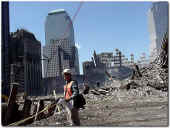 I spent the last three days down at Ground Zero, and thought I should pass along my impressions (the days largely compressed into one account) and some photos. I also thought I should get it down on paper before I forget, while it's fresh. Certainly you have read about what it's like, so I'll try to steer away from the obvious details. I spent the last three days down at Ground Zero, and thought I should pass along my impressions (the days largely compressed into one account) and some photos. I also thought I should get it down on paper before I forget, while it's fresh. Certainly you have read about what it's like, so I'll try to steer away from the obvious details.
On Friday the 14th at 3:00 PM I got a call to bring whatever utility information I had on the World Trade complex to the engineering firm of Muesser Rutledge. One thing has led to another, and I've found myself ever more involved in the effort to assess the damage, assist construction crews in evaluating the support value of certain areas for titanic cranes and ultimately scope out the work that lies ahead to reconstruct downtown. My immediate task was surveying/locating what utilities and manholes I could find on site so that I can tackle the task of mapping the utilities surrounding the complex at the time before the collapses.
Under the auspices of AMEC Construction, my co-worker Jim and I were given two entrance badges - the most important being the red Mayor's Office of Emergency Management pass - along with out company photo ID's.
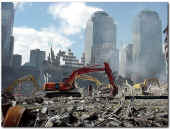 The way down West Street to Ground Zero is lined with numerous tents and mobile offices, all of various agencies from ATF to NYFD to New York City Department of Environmental Protection. As we headed south, all we could see was smoke from the site ahead, along with cranes and an increasing number of excavators. Naturally, there were crowds of firemen, who seemed about the best organized, but also an astounding number of cops from different agencies and departments seemingly quite removed from the task at hand (Narcotics?), so many so that it was somewhat intimidating. We fell into the minor class of participants comprised of construction managers/engineers, the non-uniformed and non-laborers. Well, we were wearing safety vests, helmets with our company logo and carrying manhole hooks, a measuring wheel, nap sacks and clip boards, so in a way we were uniformed. The way down West Street to Ground Zero is lined with numerous tents and mobile offices, all of various agencies from ATF to NYFD to New York City Department of Environmental Protection. As we headed south, all we could see was smoke from the site ahead, along with cranes and an increasing number of excavators. Naturally, there were crowds of firemen, who seemed about the best organized, but also an astounding number of cops from different agencies and departments seemingly quite removed from the task at hand (Narcotics?), so many so that it was somewhat intimidating. We fell into the minor class of participants comprised of construction managers/engineers, the non-uniformed and non-laborers. Well, we were wearing safety vests, helmets with our company logo and carrying manhole hooks, a measuring wheel, nap sacks and clip boards, so in a way we were uniformed.
Numerous checkpoints come and go, though why there are multiple layers for ID checks I can only conclude has to do with redundancy and quantity to compensate for actual efficiency. This observation was borne out frequently and is a constant in the Zone.
The first wreckage we came upon was on Vesey Street. 7 World Trade's bulk had been cleared from Vesey but loomed, smoldering 6 stories high with grabber rigs like giant yellow ants on a mound of black shredded wheat, their pincers snapping away at it. Washington Street branches north from Vesey and is blocked by the 7 WTC debris, which is shunted up against 140 West Street, the Verizon Building. That's where the switches are that downed my email and connectivity. On the other side of the building, a squad of Verizon employees ran thick black cable across a makeshift wooden bridge to an adjoining building where new switches are being installed (soon, I hope.) Anyway, I thought this pile of debris very impressive on it's own. All the beams from the building are layered out flat and orderly, like they were placed that way carefully and then set afire. I'm told that's because the building came down slowly, collapsing near the bottom and folding gently in on itself.
At the end of the block one hits Church Street, which is the eastern boundary of the WTC complex. Church Street has taken on a carnival-like quality, lined with tents of all kinds: Red Cross, canteens, FBI, Prayer Shelter, latrines, stacks of bottled water, boxes of respirator filters, wash stations (for eyes and clothing, boots...) Crisscrossing the lane, amongst the various uniforms, we now add more firemen and quantities steel workers, some on there way to work. Others to the side doze on chairs in makeshift lounges.
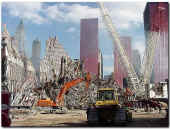 Add volunteers, yet another class of participant. They dart around - both on foot and in ATV's - trying to give everybody and anybody food and water. But few accept. There is so much food and drink at every turn, bins and bins of snack food and Red Bull, that I suspect the firemen will return home a none too svelte. You almost want to take something from the volunteers, as they seem to desperately want to help. Perhaps last week, when the rescue effort was dire, and there was less food, their services were more appreciated. We even saw a woman roaming around with a sign that read, "MASSAGE." Firemen joked with her, and I'd guess that may have been par for the course for her trouble. You can't but wonder who authorized her to enter the Zone. Not that massages aren't nice, but there's enough confusion down there already. A mobile McDonalds is there, on Fulton Street, with a little crank-up illuminated sign and everything. They don't serve anything but chicken nuggets and Quarter Pounders with cheese. But it's free, like everything in the Zone. Add volunteers, yet another class of participant. They dart around - both on foot and in ATV's - trying to give everybody and anybody food and water. But few accept. There is so much food and drink at every turn, bins and bins of snack food and Red Bull, that I suspect the firemen will return home a none too svelte. You almost want to take something from the volunteers, as they seem to desperately want to help. Perhaps last week, when the rescue effort was dire, and there was less food, their services were more appreciated. We even saw a woman roaming around with a sign that read, "MASSAGE." Firemen joked with her, and I'd guess that may have been par for the course for her trouble. You can't but wonder who authorized her to enter the Zone. Not that massages aren't nice, but there's enough confusion down there already. A mobile McDonalds is there, on Fulton Street, with a little crank-up illuminated sign and everything. They don't serve anything but chicken nuggets and Quarter Pounders with cheese. But it's free, like everything in the Zone.
All this against the backdrop of destruction: the burned out 5 World Trade, the slow rise of smoke, twisted ruins, acrid smell and skeletal steel remains. The pictures say it best.
We had to deliver a plan I devised of the slurry wall to the fire chief, and we went to the Church Street FD tent. In a corner of the tent was a two by two piece of an airplane fuselage, and a spackle bucket with assorted personal effects pulled from the wrecks: a melted camera, a shoe, a wallet. There was some problem locating the Chief until a resting fireman said he'd take us to him. We were led up to one of the more secure parts of the site, and area opposite Dey Street in which only very select people can go. It's here on a sort of ship's bridge that the rescue effort is most intense. That is, it's where most of the bodies have been coming from. You walk up the granite steps to the plaza area, reminded of when you did it last and the scene was so much different, back the way it was. Buttresses and ramps of wood support a large crane here, and in front of it, just where the granite ends and the ground drops off into a shallow valley of steel and concrete, are detachment of grim commanders lording over search teams and squads of firemen. They pick through a smoldering field of somewhat leveled rubble that's loaded into containers for the crane to lift away. Body litters and blankets are at the ready. While I waited, I discreetly lifted the camera from my belly bag and took a hip shot, attached, which will give you some idea.
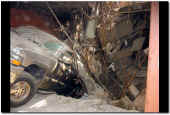 I should note that photography became increasingly discouraged, and so I got mine discreetly. There is the sense that "This isn't Disneyland." Respect for the tragedy is necessary, and yet people want to remember, to have a piece of this profound experience. I can't say that I know the answer. (On Thursday they were even stopping the people at the barricades - blocks away - from taking snap shots.) I should note that photography became increasingly discouraged, and so I got mine discreetly. There is the sense that "This isn't Disneyland." Respect for the tragedy is necessary, and yet people want to remember, to have a piece of this profound experience. I can't say that I know the answer. (On Thursday they were even stopping the people at the barricades - blocks away - from taking snap shots.)
I saw a sculpture in the wreckage, a metal planetoid thing, one I recognized from the plaza, but couldn't place where it had been. That was common. I would see something like a smashed kiosk or a street heaped with wreckage, one I walked down dozens of times before and go, "I remember that. But where was it? What did this all look like before?" And I just get glimpses, pieces, but can't put it together. Strikingly similar to trying to remember a once-vivid dream.
Amongst all this we did our survey of Church Street's various manholes, curbs and street hardware. After a couple hours, we looked up from our work and realized the scurrying around us had slowed, and ultimately it stopped. Police were lining up. We stopped working and stood by as more police came in all manner of dress, from coveralls to blues to blue jeans to suited detectives to National Guardsmen. Slowly, an ambulance came down the silenced midway and backed into to the "ship's bridge" area. A detachment of firemen came down the steps from the bridge, pawl bearers, holding an orange, blanket- covered litter that didn't look very heavy. When the ambulance moved forward, an order was barked and the gauntlet of police saluted. Citizens like me held our helmets over our hearts. Moments later, the midway was bustling again, and I had to fend off more snack food.
While I looked at the wreckage quite a bit, my eyes were on the ground a lot for my work. I expected to perhaps see things I wish I hadn't, but the debris I saw was mud, discarded respirator filters, crushed water bottles, wrappers, etc. I should add that among all the other myriad people around were sanitation workers sweeping up garbage and trying to wash away mud. Even at close inspection of the piles of rubble, you don't even see a desk, a calendar, nothing that belies the human toll. There is only the smell of burning carpet and smoldering steel that most New Yorkers have now come to associate with the whiff of disaster.
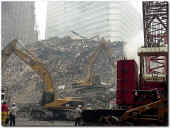 Of note is the dust that covers everything, the residue of all that gypsum and concrete dust. Whether on windows or signs, the fingers of the workers have written graffiti in the dust, some vengeful, much noting who was here and from all parts of the country. In a way, it's this graffiti that really gives one the sense that this inspired bedlam isn't just New York at work but America at work, and in the typically gruff, eclectic American way. I should add that I expected the firemen, police and other workers who'd been there from the beginning to be somewhat offhand to non-rescue personnel such as myself. This was not the case. A sense of camaraderie really did permeate the place, and everybody was very deferential and familiar and going out of there way to help, move a vehicle or equipment that blocked our view, etc. Of note is the dust that covers everything, the residue of all that gypsum and concrete dust. Whether on windows or signs, the fingers of the workers have written graffiti in the dust, some vengeful, much noting who was here and from all parts of the country. In a way, it's this graffiti that really gives one the sense that this inspired bedlam isn't just New York at work but America at work, and in the typically gruff, eclectic American way. I should add that I expected the firemen, police and other workers who'd been there from the beginning to be somewhat offhand to non-rescue personnel such as myself. This was not the case. A sense of camaraderie really did permeate the place, and everybody was very deferential and familiar and going out of there way to help, move a vehicle or equipment that blocked our view, etc.
The dust had permeated closed shops, and a Hallmark store had figurines with happy faces - clowns, dollies - in the window and caked in dust. At one end of the display were figurines of firemen and police, each a still life of them cheerfully performing their duties - caked with dust. Eerie.
The streets have trenches cut in them for fire hoses and electrical cable to work lights. Sidewalks have wooded electrical ducts being constructed at a furious pace by Con Ed to restore power. I suspect many of these wooden ducts, which act like boardwalks now, will be there for some time to come. Telephone crews are cutting up the side streets and putting their new ducts in the ground. I've been told by Con Ed that the utilities have had more damage done to their facilities after the disaster - by other each other cutting the road indiscriminately - than by the cataclysmic event itself.
Yet another class of folk on the scene are the suits, mucky mucks, commissars and politicians down there to survey the damage. Nobody stops them from taking pictures.
High above the fray, workers were unrolling bright orange mesh over the fronts of the surrounding buildings. Many of the facades were damaged and giant blades of shattered glass hung precariously, so the mesh was being installed to keep debris in place. The effect of draping these forty story buildings in orange mesh looks like a Cristo art installment. You should be able to see some of this in the photo.
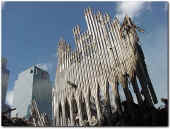 Down on Liberty Street, a row of stores/delis have been commandeered and made into canteens and yet more command centers, strings of bare bulbs inside are lit by noisy generators on the sidewalk. It's here that the vistas of the destruction are perhaps the most striking as you take in the sweep of the standing fašade structures of both towers and legions of hungry grabbers munching metal and spitting it out in trucks. South of Liberty, on Chambers, is a mile of dump trucks waiting their turn. I ran into a Tully (contractor) supervisor I know, and he was telling me that there's a growing competition amongst the four contractors to see who can get the biggest crane. On Thursday I saw an enormous red crane, so large that it must have been brought in on a ship. The base of it must be about 20' by 70'. It wasn't fully assembled or operational yet. Down on Liberty Street, a row of stores/delis have been commandeered and made into canteens and yet more command centers, strings of bare bulbs inside are lit by noisy generators on the sidewalk. It's here that the vistas of the destruction are perhaps the most striking as you take in the sweep of the standing fašade structures of both towers and legions of hungry grabbers munching metal and spitting it out in trucks. South of Liberty, on Chambers, is a mile of dump trucks waiting their turn. I ran into a Tully (contractor) supervisor I know, and he was telling me that there's a growing competition amongst the four contractors to see who can get the biggest crane. On Thursday I saw an enormous red crane, so large that it must have been brought in on a ship. The base of it must be about 20' by 70'. It wasn't fully assembled or operational yet.
Our work completed for the day, we went up to meet with some people from NYC Department of Design and Construction, which is up near Chambers Street in a commandeered intermediate school. The halls were chock-block with boxes of supplies, many torn open yet still full, and in no seeming order. There were boxes of respirators, pink respirator filters, T-shirts, tube sox, sweat pants, gloves, rags, and more snack food. Stacks of new white plastic buckets were everywhere (I guess for bucket lines) and there were a few signs taped to the walls identifying which classroom held what agency.
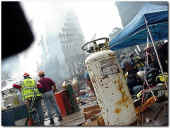 When we passed the final checkpoint on our way out, there are workers spraying down all the vehicles leaving the site to spray off the mud and dust, to contain the muck. Jim wanted to have them spray his shoes, but I suggested that he might just get knocked off his feet by the force of the spray. In hindsight, of course, I should have encouraged him, purely for my own amusement. When we passed the final checkpoint on our way out, there are workers spraying down all the vehicles leaving the site to spray off the mud and dust, to contain the muck. Jim wanted to have them spray his shoes, but I suggested that he might just get knocked off his feet by the force of the spray. In hindsight, of course, I should have encouraged him, purely for my own amusement.
A note on respirators: Jim met a fireman friend down there who told us there were about five different kinds of respirators, each with different filters, so that the workers were forever without the correct filter (which clog with dust and need regular replacement.) So the firemen and other workers were forever in search of their own cache of filters, which get discovered and are looted. He also told us that a few local taverns were back up and running, and doing well with the firemen who pop in for a beer or two and then back to work. Of course, they're not supposed to drink on the job, and so these pubs have become like speak easies, operating at a very low profile so that if you didn't know they were open you wouldn't even try the door. The fireman said that when he went there, he was expecting a small, subdued crowd but found the opposite. He didn't want to be seen there, but everybody else was seeing everybody else there, so...
The last day I went there - Thursday - was much different. I was actually guiding one of our company principals through the site to survey structural damage that may involve his department. So I didn't have any work to perform. The midway was cleared of much of the peripheral tents and copious food, though the volunteers continued to ply. No prayer tent, no massages. A considerable reduction in personnel was also evident. Now it was largely those who should be there: construction workers, some firemen, some regular police, a few ambulances and the National Guard. The rescue, the desperation is clearly over, and the sense of tension that permeated the area around the ship's bridge had even ebbed. Street sweeper trucks were spraying water, and the streets were getting cleared of mud. Cameras are now strictly forbidden under threat of confiscation.
I may have to go down to check a few things over the next few weeks, and it will be interesting to see how much debris is cleared and how things become more organized. My work continues here in the office, but I feel somehow privileged to have had the opportunity to witness the scene during the waning hours of the rescue effort. On a personal level, it has also helped me surmount the debilitating dismay of the past few weeks. Last night, I actually slept well for the first time since the 11th.
Brian M. Wiprud
LINKS
AND ADDITIONAL INFORMATION:
 |
Article
on Brian Wiprud in the New York Times
 The
December 11, 2001 New York Times included an article on
Brian: The
December 11, 2001 New York Times included an article on
Brian:
"Holmes Had His Pipe. This Sleuth Has
Thousands." To read, click
here |
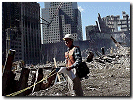 |
Brian
and the work on the World Trade Center
 Design
Build Magazine Design
Build Magazine
 Engineering
News Record Engineering
News Record |
|
|

|